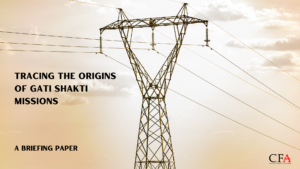A Briefing Paper
This briefing paper looks at large linear projects being implemented in India and the influence which international financial institutions are seemingly able to exert on the governments to follow their recommendations through their various research reports, studies, data analytics, country ratings and rankings, etc. This aspect is nothing new or startling, along with financing of the varied projects, IFIs like the World Bank and others have also been extending policy advice to the governments on various sectoral issues from the past several decades, from water and electricity to health and infrastructure. The industrial corridors planned in India such as the Delhi Mumbai Industrial Corridor (DMIC) as well as the newly launched Gati Shakti plan appear to be following similar set of such recommendations from the bank and its allied institutions. The link between the two might not seem obvious to some, but it appears that some of the research and studies that the bank has done on this kind of infrastructure projects could have been an inspiration in the least. The article looks critically at the Web of Corridors report published by the World Bank, and in the context of the above mentioned report and the approach that it propagates attempts to analyse the newly launched National Gati Shakti Master plan.
The Government of India has been making huge allocations for infrastructure projects in its budget in the previous years. In FY (2019 – 20) allocating Rs 4.56 lakh crore (US$ 63.20 billion) for the sector. Similarly for FY (2021-22) the budget allocations for infrastructure sector have been raised to Rs 7.5 lakh crore. The IFIs have also estimated and analysed the amounts of investments required for infrastructure sector in the country in the next decade or so.
International Finance Corporation (IFC), the private lending arm of the World Bank (WB), estimates that 2018 to 2030 India needs USD 2.2 trillion. A 2019 report by AIIB on infrastructure finance states that AIIB’s priority is to mobilise private capital into infrastructure. AIIB’s strategy on mobilising private capital for infrastructure (2018) spells out its vision as a bank that will help develop emerging market infrastructure as an asset class.
ADB’s report titled Meeting Asia’s Infrastructure Needs estimates that as per the baseline estimates the cost to address India’s infrastructure deficit is around USD 230 billion per year. However, as non-performing infrastructure assets of previous PPPs proliferated, the private sector’s participation in infrastructure dropped from over USD 55 billion (2010) to USD 5 billion (2015). This is associated with the lower viability of many PPP projects due to implementation delays, lower-than-expected revenues, and other risks that had to be borne by investors.
The WB notes that the Government of India estimates that under the 12th Five-Year Plan USD 1 trillion will be needed to bridge India’s infrastructure gap. The World Bank has also argued that the “Transport corridors can generate wider economic benefits and costs through their effects on a potentially diverse set of development outcomes, such as economic growth, poverty, jobs, equity, environmental quality, and economic resilience.” A paper published in 2018 titled ‘Transport Corridors and Their Wider Economic Benefits: A Critical Review of the Literature’ by the Bank augmented this argument further.
The paper undertook a quantitative review of the literature that estimates the economic benefits of large transport infrastructure projects and conducted a meta-analysis of 234 estimated impacts found in 78 studies. The paper focused on roads, rails, and waterways because transport corridors based on these modes have clearer potential for economic spillovers. Significantly it showed that, estimated impacts of corridor interventions on economic welfare and equity tend to be beneficial, while they are often detrimental for environmental quality, and possibly also for social inclusion.
Read more here: Tracing the origins of Gati Shakti Missions
Centre for Financial Accountability is now on Telegram. Click here to join our Telegram channel and stay tuned to the latest updates and insights on the economy and finance.

